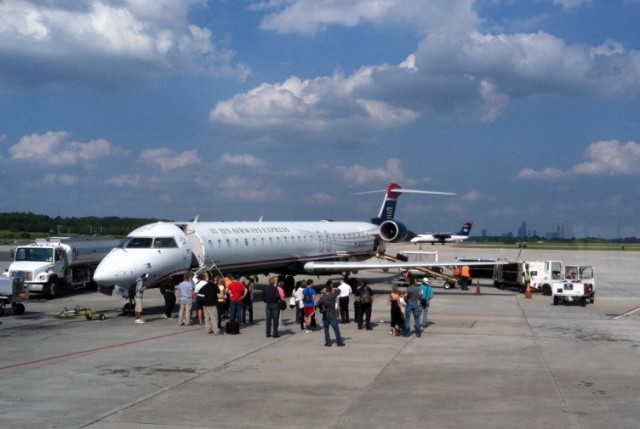
People picking up their bags. Photo by Andrew Vane.
This Story was Written by Andrew Vane for AirlineReporter.com:
Although not filled with the glory of a wide-body international flight typically experienced by others, any opportunity to fly commercially always brings a smile to my face. Getting to fly, no matter the distance or aircraft, is what being an #AvGeek is all about! To quote a childrens book titled ’œRailroad Toad’ by Susan Schade and John Buller (that I used to read to my children): ’œGive me a ticket to anywhere, the farther the better I don’t care!’
Well, that opportunity rolled around again for me. This time, I got to fly for business from my home city of Charlotte, North Carolina to the capital of Pennsylvania, Harrisburg. Up one afternoon and back the next is all I had time for with this trip.
To give you some background on Charlotte-Douglas International Airport (CLT), in 2012 it was the eighth-busiest airport in the US and had more domestic flights than New York’s LaGuardia and Kennedy combined. As a major hub to US Airways (soon to become American Airlines), the airport has grown from three small crisscrossing runways in the 1960’s to four long runways capable of handling an A340-600 or Boeing 777. CLT officials are also planning to give the longest runway a 2,000 foot extension at some point in the future. Hmmmm. My last fortune cookie said ’œI see big things in your future’ so perhaps someday an A380 will grace CLT.
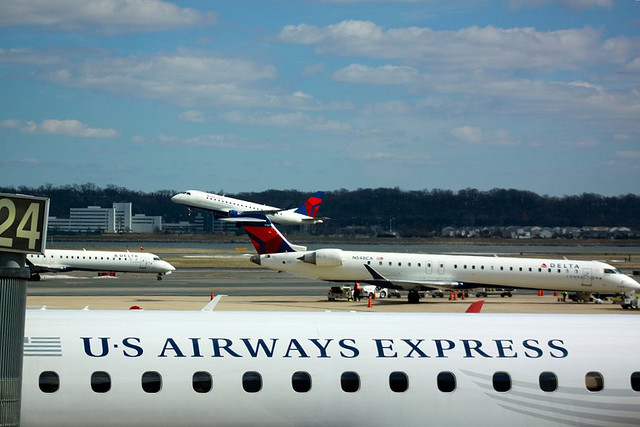
There are going to be a lot more Delta widgets seen at LGA soon.
Recently, Delta Air Lines announced their game plan to expand at LaGuardia Airport (LGA) after their slot swap with US Airways. Delta, being the world’s second largest airline, has plenty that they can bring to the New York area and grow LGA into a major hub for business travelers.
If you scroll through the new Delta LGA flights, you will see a lot of smaller aircraft: the Embraer ERJ-145, E-170, E-175, Bombardier CRJ-700, CRJ-900 and the CRJ-200. With an airport that is already so crowded, it was a little surprising seeing so many small aircraft.
Just because a new route starts as a smaller aircraft, doesn’t mean that Delta can’t upgrade to a larger aircraft later. Still, it seems like some of the routes might be able to handle larger aircraft, why did Delta go this route?
“It’s purely a function of having the right aircraft for the right market,” Morgan Durrant, Delta Spokesperson explained to AirlineReporter.com. “LaGuardia is arguably the most restricted airfield in the world but that doesn’t preclude the market demand for both capacity and frequency. Utilizing regional aircraft in some markets allows us to achieve both in a way that’s good for customers and good for business.”
At least Delta is operating jets; US Airways Express (aka Piedmont) flew quite a few turbo-props in LGA. For the airline nerd (that many of us probably are), turbo-props are fun to fly in, but I know that most travelers do not share our passion for aviation and most prefer the comfort of a jet. And remember, that not all regional jets are created equally. Many of Delta’s jets that have more the 50 seats contain amenities found on larger aircraft.
“Delta Connection aircraft larger than 50 seats will have a two-cabin configuration and Gogo Wi-Fi,” Durrant stated.
Delta has more connections and are arguably using better aircraft, so I wouldn’t be surprised if they are able to become quite successful out of LGA. I also wouldn’t be surprised to start seeing larger planes operating in Delta colors in the future out of LaGuardia as well.
Two view points you have to read about this topic are: Brett Snyder looking at the winners and losers of this deal and Dan Webb looking at the new destinations.
Photo by: Jerome Vorus
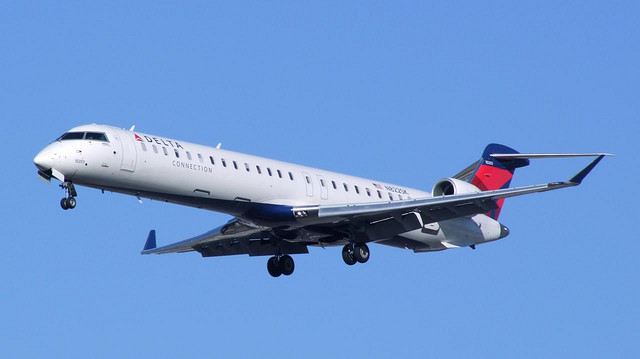
Delta Air Lines / Mesaba Bombardier CRJ-900.
It is time once again to share an #AirlineLove story. This one is from Jason Rabinowitz (aka @yankees368) who recently took a Delta Air Lines flight from Detroit Metropolitan Wayne County Airport (DTW) to John F. Kennedy International Airport (JFK). Here is his story in his own words:
You recently wrote about how many of the emails you get bitch about some bad experience with an airline, but don’t often read about good experiences. Well, I have a good one for you. The airline is Delta. I know, I know, very unexpected. Delta and I have a very checkered history over the last four years, so this was something I felt had to be shared.
I was booked on Delta Connection/Mesaba from DTW to JFK at noon Wednesday before Thanksgiving. Security at DTW had no wait and a lot of TSA personnel, very nice. Aircraft was a CRJ900, not the biggest, but not tiny. For whatever reason, Delta has really cut back on their DTW-JFK route, and they are down to three a day (two on a CRJ900 and one A319). I am very surprised that they did not add capacity due to the holiday, but I digress.
When I checked in at a kiosk, I was presented with the screen asking me if I would like to put my name on the volunteer list to be bumped. I agreed and proceeded to the gate. The gate agent eventually called me up and informed me that the flight was oversold by three passengers. I happily took the opportunity to get a $400 voucher and be moved to LaGuardia Airport (LGA), as there really wasn’t any space going to JFK. I even asked for a first class upgrade, which she happily agreed to.
Flash forward 15 minutes later at the gate and my seat assignment turns into 22C! Thats the last row on their A319. Hardly first class, but I am happy to be in a seat. I hopped on Twitter, asked @DeltaAssist what the deal was, and they apologized and gave me another $25 voucher. Now we are at $425 voucher credit + $6 meal voucher.
Just before our 12:10pm push back, air traffic control stops traffic at LGA until 1pm. Uh oh, I know how these 1 hour delays turn into 2 then 3 then 7, so I needed to act fast and get something to eat. I asked the flight attendant if the door was still open and if I could grab something to eat, and they said sure! However, when I went up the jet bridge, the gate attendant informed me that I could not deplane and re-board, as she plane would no longer be secure. She then offered to personally escort me to the food court right around the corner while I grabbed a snack, with a smile on her face the entire time! Wow.
The flight was bumpy but fast, and now I am at LGA instead of JFK. I figured I would take a shot in the dark and ask a Delta red coat if they would provide a coupon for a cab ride to JFK. A few smashes of the keyboard later, she prints out a voucher and tells me to wait for a car. Holy crap, the car they called was an all black Cadillac Escalade, all for me. Again, wow!
For whatever reason today, everyone at Delta went above and beyond what they needed to do, and made my day easy (and profitable). I first started flying Northwest Airlines (which merged with Delta) when I moved to Michigan in 2008, right when they probably gave up. For what its worth, things didn’t start to go downhill until the Delta name was slapped on the ticket. It once took me 3 days to get from DTW to JFK! Yowza. Now, this summer I got from Lansing’s Capital Region International Airport (LAN) to Yankee stadium in 4.5 hours. Delta has come a long way.
So, where should I go with my $425 voucher? (I say come to Seattle -David)
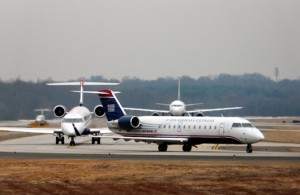
US Airways Express (PSA) CRJ 200 on the taxiway followed by ’œCompany Traffic’ CRJ 700
When passion, creativity, photography and the ability to write combine with fans, I love to share their work. This is a blog written by Andrew Vane for Airline Reporter taking a close look at Bombardier’s CRJs:
Canadian company Bombardier Aerospace acquired government-owned Canadair Ltd and entered the regional jet market in the 1980’s. Today the most commonly seen and flown CRJ’s consist of the CRJ-200 (50 seats), CRJ 700 (75 seats) and CRJ900 (90 seats). CRJ’s are most popular amongst the major airline’s subsidiaries for shorter domestic flights between hubs and along spokes. Here in Charlotte (KCLT), virtually all of Terminal E is occupied by gates to serve regional jets and turboprops. Similarly, in Cincinnati/Northern Kentucky Airport (KCVG), Delta dedicated a major portion of the largest terminal to their regional jet carrier Comair.
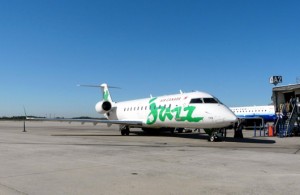
No this ain’t headed for New Orleans. It’s an Air Canada Jazz CRJ 200 bound for the Great White North.
The CRJ 200 is an upgrade to its -100 predecessor with the addition of more efficient engines coming in Extended Range (ER) and Long Range (LR) versions. Guess which one is longer? Answer: Without consulting Bombardier’s data, your guess is as good as mine. (Per the web site the range of the ER is about 1,800 miles and the LR version is 2,300 miles.) CRJ 100/200’s are most common domestically among the major airliner’s regional carriers Comair, Skywest, ASA, Air Canada, MESA, US Airways Express (PSA), Skywest and Republic.
First entering service in 2001, the CRJ 700 series provided a bit more seats and comparable range to the LR version of the CRJ 200. In profile, the easiest way to tell the difference between a -200 and -700 is the fact that the -700 is longer and the rear end is sticking up in the air. In addition to more seating, the CRJ700 features a new wing with leading edge slats and a stretched and slightly widened fuselage, with a lowered floor. CRJ 700’s are most frequently flown in the US by Air Canada Jazz, American Eagle, ASA, Comair, Horizon Air, Mesa, Skywest, and US Airways Express (PSA). A further refinement of the CRJ 700 was the CRJ 705 series, operated by Air Canada, which added 75 seats and split the aircraft into business and economy classes of 10 and 65 seats, respectively. Only sixteen 705’s were built.
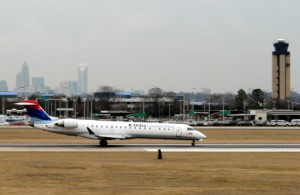
ASA ’œAcey’ CRJ 700 rolling on 18C at Charlotte-Douglas International Airport.
Eventually, this French Canadian company, who also produces the popular Dash-8 family of turboprops, expanded the CRJ fleet design to include a longer -900 version. The CRJ 900 features a ’œcomplete re-design of all of the structure and systems. In addition, an all-new wing was developed that increases the cruise speed of these aircraft while offering excellent airfield characteristics. These aircraft also feature an all new interior cabin that offers increased room for the passenger, enabled by a lowering the floor by 1’ (2.54 cm) and redesigning the aircraft frame RJ900 that featured as of the original CRJ200, offering more headroom and a wider cabin. The seating and bins were completely redesigned to allow more passenger space and increased bin stowage,’ says Bombardier’s web site. CRJ 900’s are currently operated by Mesa Air, Air Canada Jazz, Skywest, Comair and Pinnacle Airlines.
From my own personal experience, I was a bit disappointed with the window placing and height for my 6-foot tall frame. I ended up with a neck ache each time I sat by a window. The windows are much lower compared to Bombardier’s Brazilian competitor, Embraer.
Some airlines have planned a future full of regional jets in lieu of larger aircraft with empty seats. Smaller aircraft lower to the ground provide easier boarding in variable conditions (jetway or stairs). With over 700 CRJ’s of all versions delivered by Bombardier in the last 30 years, chances are you’ll be riding in one of these the next time you fly out of a small city.
Bombardier’s CRJ story here.
Images: All photos by Andrew Vane
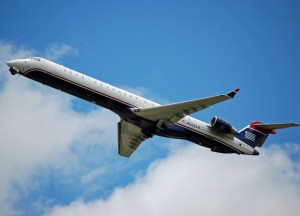
US Airways CRJ-900, operated by Mesa Airlines. This is one slick looking plane.
Recently I flew from Seattle (SEA) to Tucson (TUS) with a stop in Phoenix (PHX) on US Airways. The first leg was on an Airbus A320 and then a very short layover before heading down to TUS on a CRJ-900 regional jet. Since my flight out of SEA was at 5:15am and I woke up at 2:30am to catch the flight, I slept the whole way down to PHX. That makes for a pretty poor review, so I decided to share the shorter of the two flights: PHX to TUS on US Airways Express (operated by Mesa Air). The flight is very short, only 23 minutes, meaning no beverage service and very little time to even turn on your electronics.
This was my first flight on a CRJ-900. Being based on the west coast, we really didn’t see many regional jets until recently. Even now, we don’t see nearly as many regional jets as folks over on the east coast. Not too long ago, I flew a CRJ-700 for the first time and had mix feelings about the aircraft.
First off, the gate agent was probably the best I have ever experienced. It seems that so many gate agents are hardened by annoying and demanding customers that you don’t see too many who are genuinely friendly. She was welcoming everyone by last name, “Welcome Mr. Brown, how are you today?” – and then actually interacted with each passenger as they boarded.
When getting on the aircraft I could help but notice there were America West emblems on the seats and the bulkhead. (I forgot my camera, so the photos are from my iPhone). Most people probably didn’t notice, but as an airline nerd, this was very odd. US Airways and America West merged in 2005, giving over five years to re-brand the regional fleet. I am big on airlines having consistent branding and although fun to see the old America West logo, it does no good having passengers stare at that logo during their flight. I contacted US Airways via phone and email, but as of posing this story, I have not received a reply. I assume this must have to do with Mesa Air (which operated the flight) filing for Chapter 11 bankruptcy in January 2010.
The next issue were the windows. On the CRJ aircraft, they are widely spaced out meaning that many of them are in odd positions. For most of us in the front, we really didn’t have a window. I had one blocked by the seat in front of me and one behind my shoulders. Sure, most aircraft have a dead spot in a row or two, but most seats on the CRJs have this issue. Just like flying on the CRJ-700, my neck was sore by the time we left the gate from looking out the window. I understand that the windows need to be spaced out for structural integrity and it is up to the airline to figure out seat spacing, but that doesn’t mean I have to like it.
The flight was only going to be 23 minutes so what did it matter, right? Well, the flight itself did only take about 23 minutes, but it took us over 40 minutes to take off after leaving the gate. It is difficult when you have in your mind that you will only have to sit on the plane for 23 minutes and it ends up being over an hour. Especially when you can’t be on your phone or laptop during that whole time on the ground.
This must be a common occurrence for this flight, since it was scheduled to leave at 9:56am and arrive at 10:55am. When you consider it only takes two hours to drive between the airports, if you need to rent a car in Tucson, it might be better just to rent the car in Phoenix and drive. I can’t believe I am saying that, since I would normally take any opportunity to fly when I can, but sitting in a plane not being able to see out the window for so long on the ground, with people from Arizona who think 75deg is cold (I was sweating the entire time) is just frustrating.
Most times on smaller aircraft I feel more connected to the flying experience, but this time I felt disconnected. It could have been the heat, the large guy sitting next to me or the odd yellow interior lighting of the airplane (lack of sleep might have been a factor as well). All I know is having a real window can make a huge difference and I will be double checking my seat placement before I fly on another CRJ.
Image: Willamor Media






